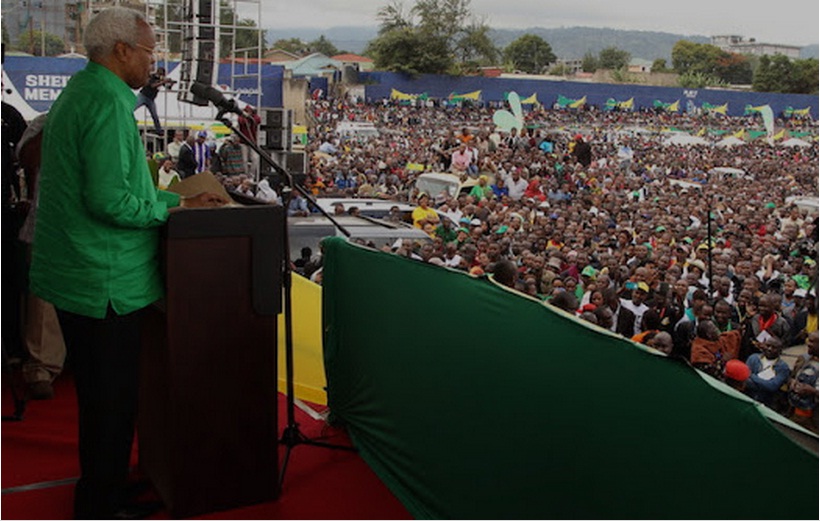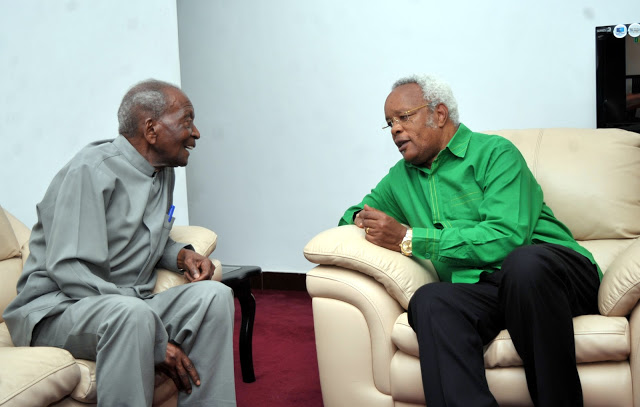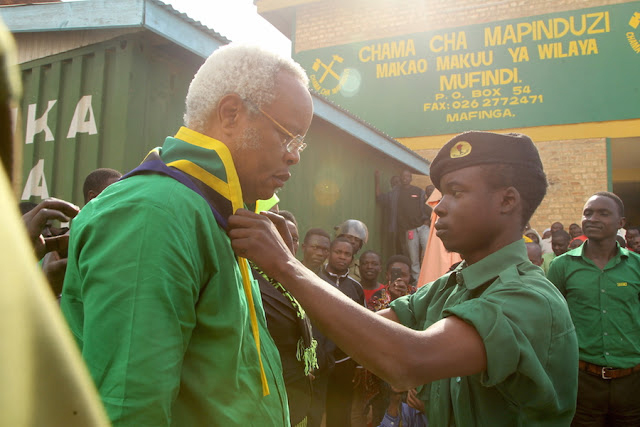
Edward Ngoyai Lowassa addresses a public rally on 30th May 2015 in Arusha Tanzania. Internet File Photo
By Jaston Binala.
Edward Ngoyai Lowassa’s apparent lead as preferred candidate for nomination as ruling Chama Cha Mapinduzi (CCM) party presidential candidate is ‘unfortunate’, the US-based environmentalist organization Save the Serengeti has said in a statement.
“Tanzania’s upcoming election is critical for the future of [the country’s] wildlife,” the statement reads in part. “So much has been lost during the past ten years that another administration that is indifferent to Tanzania’s great natural heritage, and that does not understand the urgency of action required to save what is left, will preside over its demise.”
The statement e-mailed to this reporter continues: “Unfortunately, the leading candidate at this point has been a hardcore advocate of the infamous Serengeti highway.
“He previously told crowds that he would make sure the road was built regardless of its impact on the migration and said he was ready for a showdown with environmental and conservation groups. Now he’s just announced support for a harbor that would destroy a marine national park”.
The organization Save the Serengeti, which also runs the project ‘Serengeti Watch’ expresses a desire to inform Tanzanians that conservation is actually a tool for development. The organization says it has mooted a plan to push for a public forum on Economic Development Through Conservation. Save the Serengeti suggests that candidates in Tanzania’s 2015 general election should lay out their policies on the subject of conservation.
At the time of writing this report some 42 members of the ruling CCM party had expressed interest to ask the party for nomination as presidential candidates, although two of them dropped out before completion of the nomination process which required other members’ endorsements. Lowassa got the lion’s share of endorsement signatures.
By measure of the large numbers of CCM members volunteering to endorse Edward Ngoyai Lowassa as the party’s presidential candidate, and by the huge crowds of people who turned up at meetings he addressed, Lowassa appears the candidate of choice for many CCM party members.
But there is controversy within the party on whether he will actually be nominated by the party’s filtering body—the CCM National Executive Committee (NEC)–which is understood to be split by worries scandals in Lowassa’s past might ruin his presidential race, which might in turn ruin the party’s chances to win the presidency.
TZ business News research has found Edward Ngoyai Lowassa held a ministerial level office for legal affairs in the Prime Minister’s office, and later the position of Minister of Lands and Housing between 1990 and 1995 when, for the first time in the country’s history, land grabbing issues took center stage as a disturbing political issue. Investigations indicate this is among issues which are likely to come up as campaigns heat up leading to the October 2015 general election.
One publication (Utafiti, Page 14) says of the period: There were public officials in the bureaucracy and in the parastatals who were turning public property into private property, and organised to grab land for themselves and their allies locally and internationally. Tanzania was passing through a short-term period of transformation from a socialist state to a mixed capitalist state at this time.
In the chapter on Land Disputes, the document says [a] Commission outlined the numerous and varied forms of disputes which arose, highlighting the fact that in one region there were one thousand complaints.
In the area of disputes, Arusha Region stood out both in respect to [the] fact that the dispute settling machinery was inaccessible to the majority…. It was not insignificant that this region became a political base for the opposition to the government of the ruling party in 1995, the Utafiti document says.
Edward Ngoyai Lowassa was minister in the Prime Minister’s office responsible for legal affairs, and then Minister for Lands and Housing during this period when a tract of land almost the size of a ward in Arusha was allocated to a white Kenyan national named John Stein during the period 1990 -1995. This allocation of land during the Ali Hassan Mwinyi era raised many tempers in parliament as many members of parliament opposed it.
The disputed John Stein land allocation saga covered the villages of Loiborsiret, Narakauo, Emboret, and the land area surrounding Mt. Lurkman, which was all part of Arusha region at the time. It was also during this time when the Loliondo area and tracts of land in areas known as Naberera in Arusha region at the time were given away to foreign owners– driving away the indigenous Maasai owners to go somewhere else grazing their cows.
TZ Business News investigations suggest, the displacement of indigenous land owners in the areas of Loliondo, Naberera and other places in Arusha continues to be the source of conflict up to this moment, so that land fights between Maasai hersdmen and the Kaguru peasant farmers in Kilindi district can be linked to these displacement of the Maasai in their traditional areas of Naberera, Kiteto, and Simanjiro, formerly all part of Arusha–the displacements which mostly happened during the period 1990 to 1995.
Some of these places have now become part of Manyara region–the region which has inherited, after formation, countless land disputes from the past. Read about some of these disputes at this link: PM spells out measures to solve land conflicts.
Meanwhile, the Kenya-based newspaper, The East African, has described Tanzania as the region’s lead nation for signing away huge tracts of land to foreign investors in secret deals
Tanzania leads East African countries in secretive land investment deals, the newspaper says, with the government signing off huge chunks of land to foreign governments and private investors, a new survey shows. And East Africa — a region where land is usually an emotive issue — tops the global charts on dishing out farmlands, edging out Southeast Asia, South America and Central Africa.

Edward Ngoyai Lowassa (R), discusses a point with one of his supporters, CCM party stalwart Kingunge Ngombale Mwiru. Internet File Photo.
Tanzania recorded at least 58 deals involving an estimated 2.2 million hectares, according to the Land Matrix Project, a new online database.
(Read: Arumeru, Arusha land invasions threaten commercial farming)
Kenya follows with 13 deals over an estimated 633,500 hectares. Uganda comes in third with four deals over an estimated 76,512 ha; while Rwanda tails with just a single deal over an estimated 3,100 ha. There is no information on Burundi.
While the entry of foreign investors purportedly comes with positive trickle-down effects like provision of jobs and economic growth, some security analysts and humanitarian organisations said this trend is exposing EAC countries to possible food insecurity, instability, social unrest and conflict in coming years. Indeed, it has already sparked land invasions in northern Tanzania.
Foreign governments that seek this land import most of their food and so they want it mainly to grow food and export it back to their countries. A section of politicians in Tanzania have been pushing for land reform that would see the seizure of big tracts of land owned by rich individuals and their transfer to poor, landless people — this was promised by both Cha cha Mapinduzi and Chama cha Demokrasia na Maendeleo (Chadema) candidates in the campaigns before the recent by-election in Arumeru East constituency in Arusha.
(Read: Dar’s horticultural sector at stake over land reforms agenda)
While the single land investment in Rwanda is from next-door neighbour Uganda, Tanzania’s are mainly from Germany, the UK, Norway, Sweden, Korea, and Netherlands; while Kenya’s deals come in from Canada, UK, Japan, Qatar, the US, and Switzerland.
Ironically, a majority of the countries, particularly in Africa, that are giving their land away routinely suffer from famine and starvation.
(Read: Arable land deals with the West bad for food security)
The Land Matrix Project has been created by the Centre for Development and Environment at the University of Bern in Switzerland; the Paris-based Centre for Agricultural Research for Development; the German Institute of Global and Area Studies; Germany’s lead development agency GIZ, and the International Land Coalition. The matrix, its creators said, systematically collates and seeks to verify information on large-scale land acquisitions, from 200 ha and above, that have been concluded since 2000 with the aim of providing a quantitative response to a global trend where rich countries are swooping down on poorer ones and picking up huge pieces of land on the cheap.
An accompanying report – Transnational Land Deals for Agriculture in the Global South — says that there has been a slowdown in the scramble for land, which peaked in 2009, because of “the easing of commodity prices, the financial crisis and new realism about the risks of the investments concerned.”
(Read: US agro-tech firm ‘grabbing land’ in Tanzania)
It is also possible, the report adds, that the slowdown “may also reflect a new wariness about announcing very large-scale prospective deals, and a shift in media interest to other topics.”
The wariness may result from the fact that for a time now, as these transactions have grown in scale and intensity, many commentators, including former UN secretary-general Kofi Annan, have expressed fears that a new Scramble for Africa is underway. The interactive matrix has recorded 1,217 agricultural land deals, which amount to 83.2 million hectares of land in developing countries or 1.7 per cent of the world’s agricultural area.




